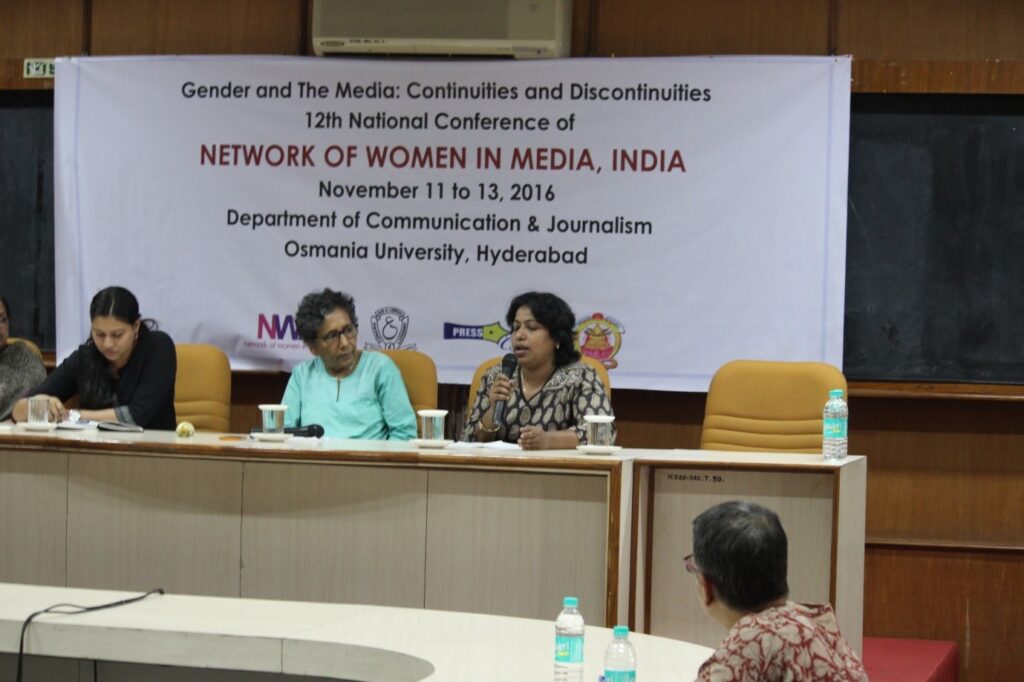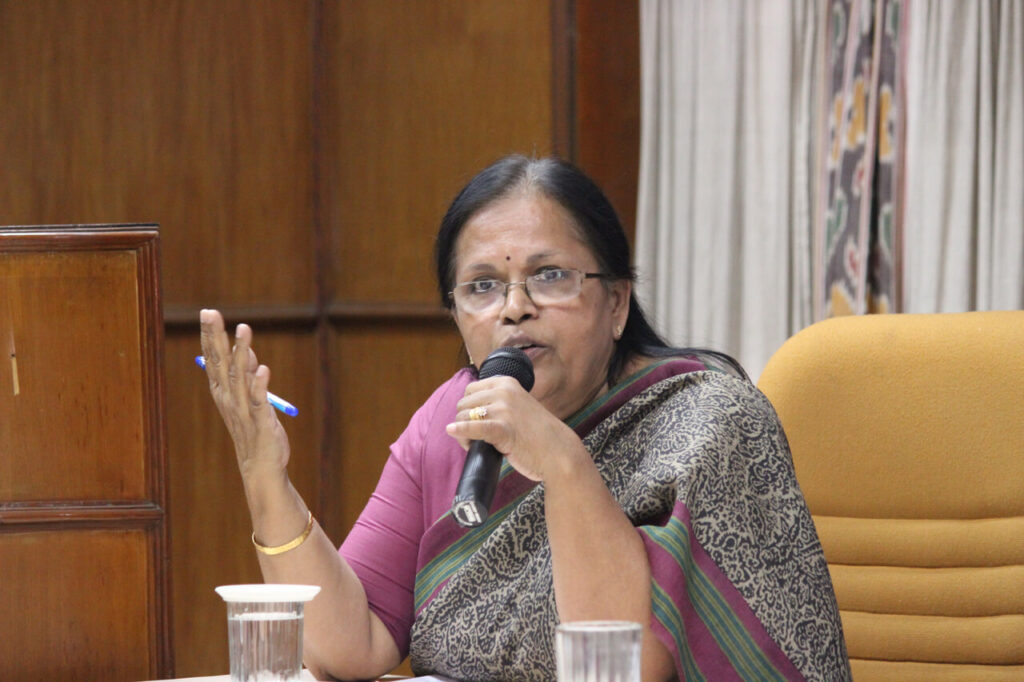SUNDAY, 13 November 2016, 11.30 am-1 pm
Working Session 5: Media Under Siege

The session to discuss current crises facing the media and journalists as professionals was prompted by the recent series of attacks of various kinds on the media and journalists, as well as the accelerated shrinking of spaces for dissenting views and voices. In her opening remarks, Kalpana Sharma, chair of the session, reminded us how any criticism or dissent is labelled as ‘anti-national’ by both central and state governments, although the stifling of the regional language press gets less “national” attention than any assaults on the English media. Journalists face the consequences of going against the grain either immediately or some time later. She pointed out that the problem is not specific to India, but a larger, global phenomenon, related to the direction in which the media is moving the world over.
Delhi-based independent journalist Neha Dixit focussed on the corporate-political nexus that determined news priorities. She recalled early days at editorial meetings where they were told their reader was a 35-year-old techie man from Bangalore and all stories had to be pitched at him: “I was told there is no ‘she’!” According to Neha, investigative journalism was usually aimed at uncovering financial or corporate scams, but the parameters of investigative journalism needed to be broadened.
She mentioned two stories she had worked on. One was from Shamli and Muzaffarnagar in Uttar Pradesh, where almost a hundred people had been killed and a lakh displaced, several raped. She spent a lot of time and effort investigating the story and uncovering the half-truths and falsehoods that were being spread. Likewise, her story on the trafficking of girls from the Northeast by three outfits affiliated to the Rashtriya Swayamsevak Sangh (RSS) – a crime that violates several laws – was tracked over months. She met the girls in Gujarat and Punjab, and wrote a water-tight story after talking to all sides. Yet, the result was not that those involved in the trafficking industry were caught, but that she had fake cases of ‘inciting communal disharmony’ foisted on her by individuals affiliated to the Sangh Parivar. In such cases, the reporter becomes the story and the focus shifts away from the need to take action against the criminals involved.
Neha also mentioned that in the last ten years of her career in journalism she has covered child trafficking extensively. “In 2010, when I wrote about child trafficking by some madrassas in North Delhi running sweatshops inside their compounds, it was a crime story for me and my editors. After the story was published, over 250 children were rescued. Similarly, in 2011, I did a story in the dense Saranda forests at the Odisha-Jharkhand border on the training camps for child soldiers run by several Maoist groups. “These articles won national and international awards and I wasn’t branded a Hindu fundamentalist ‘Sanghi’, a rabid ‘nationalist’ or a ‘capitalist thug’ for covering these issues,” she pointed out. According to her, the difference in the reaction to these two stories, on the one hand, and the RSS story (“Operation #BetiUthao/Babylift”) raises two very pressing questions: are journalistic duties subject to the whims of the political regimes in power? How can political regimes remain unaccountable for curbing the basic freedom of expression?”
Neha also spoke of the harassment that she had faced, dealing with a barrage of misogynist comments in the online space. In a lighter vein, Neha said she resented being labelled a ‘concubine of the LeT’, rather than being called an LeT operative, like Shahina! “One gets identified as a trouble-maker, and there is constant pressure to perform, while fighting about choices, whether of your career or of your partner,” she said. In such a situation, there is little scope to talk about your fears or the risks that you face. While pursuing the story on child trafficking, she was locked up by RSS members in a Saraswati Shishu Mandir for several hours, which was a nerve-racking experience. However, she didn’t bring it up with her editor, lest he tell her, “Then don’t do the story’. “But one is desperate to do the story, so one takes risks,” she said.
Shahina KK, assistant editor with Open Magazine, quipped that she was always called to public meetings in Kerala to talk about ‘media under siege’ and never about 20th century English literature which she would love to talk about – such are the times! “Often, what you want to report about – criminal activities – turn against you,” she said, describing how she was slapped with a case under the Unlawful Activities Prevention Act after she wrote about a controversial Muslim political activist in Kerala, Abdul Nasser Maudany. Her stories were used as evidence against him, as proof that he could influence witnesses even while in jail. Shahina pointed out that journalists are not asking for special rights, but only their constitutionally guaranteed rights to be able to carry out their profession. “Freedom of the press is a legal fiction in India,” she said. It is legally enforced and validated neither by the Constitution nor by any statutes. Freedom of the press is embodied in Article 19 (1) (a) of the Constitution that guarantees freedom of speech and expression. The ambit and scope of freedom of speech and expression has been widened and transgressed into the freedom of the press by the many battles fought by media institutions and individuals from time to time (with legal principles settled in cases such as Bennett Coleman and Company V Union of India, Indian Express V Union of India, Sakal Times V Union of India, etc.) Although the drafters of our Constitution adapted many ideas from those of Western democracies like the US and Germany, they eschewed specific, explicit provisions for the freedom of the press.
On the other hand, she said, there are numerous statutes that can be used against the press and media institutions in order to try and control their voices. Apart from the provisions of defamation and contempt of court, journalists have been booked under various provisions of the IPC like Section 153 A, and also under special statutes like the UAPA, the Official Secrets Act, etc. It is high time to initiate collective bargaining to get real constitutional protection for journalists in India. At the same time, she pointed out, when we say this we have to equally keep in mind the chicken-egg story of press freedom: is the freedom of the working journalist or that of the media institution she or he works for? “We cannot ignore the possibility of such a constitutional mandate being misused by powerful media institutions to serve their vested interests,” she cautioned. “A balance has to be struck and we have to find a solution.”
The isolation of journalists with cases registered against them for their writing is severe, she said. Editors do not follow up on the process or come to court with you repeatedly, hearing after hearing. Tehelka, for whom she was working at the time, did not support her except in terms of paying the bail amount, which hardly covers the years and years of legal fees and other expenses incurred as the case drags on and on. Her editors also did not understand the seriousness of a non-bailable offence being registered against her and initially did not respond to mails or calls. It was only when her bail was rejected by a lower court that they realised how serious the matter was. She has to go every three months to attend court in a different state from the one she lives in, making her own arrangements for travel and stay. “Still, at least I do have some money. What about those who do not?” she asked. She cited the case of a Dainik Jagran employee who was fighting a case against the CBI on his own resources. “The NWMI must do something to address the issues of regional language journalists,” said Shahina, highlighting the threats they received not only from the government, but also powerful political parties and other vested interests.
Putting these experiences in a broader context, Padmaja Shaw, Professor of Journalism at Osmania University (now retired), gave a brief presentation on the impact of ownership on media independence. “When free speech and the media’s role in democracies as the primary sources of information are debated, we must also recognise that what we experience as individual journalists is a symptom of a larger malaise.” A study of the Telugu news television industry since 2012 revealed that of 11 channels, nine are owned by entrepreneurs belonging to the dominant Kamma caste from coastal Andhra and two are held by entrepreneurs from the dominant Velama caste of Telangana. Except for V6 and 10TV, which are financed by resources from the real economy, all the other channels are funded by the speculative part of the service sector, such as real estate and non-bank finance, including chit funds.

Apart from the domination by caste and regional interests, which exacerbated the separatist sentiment before the bifurcation of the state, the direct and indirect participation of politicians in the news media industry and the perpetual financial losses incurred by the channels, indicate that the common argument explaining away sensationalised news coverage as merely a business strategy to garner TRPs is suspect. Media houses that are invested in the local political stakes remain in the market even though they are in the red year after year.
“Politicians and speculative business interests have taken over the news television industry and are driving their own agendas,” said Padmaja. Many channels have been unable to pay salaries on time. There have been mass retrenchments in 2014-15 of middle and senior positions in newsrooms. There is greater reliance on untrained and underpaid recruits who have little understanding of the larger mission of journalism in a democracy. In this general atmosphere of siege, women journalists have been finding it more difficult to work and survive, she said.
According to her, the media is under siege from two forces. First, the state and its various coercive arms, which are more visible and can be challenged to an extent by invoking the extension of Constitutional guarantee of free speech to media. But when the media come under the siege of dubious financial and political forces, it is a fight against a more insidious enemy. It has to be fought at the regulatory, structural and systemic levels. There has not been much introspection in the media about this, she pointed out.
Throwing open the discussion, Kalpana remarked that there was a significant absence of implementation of laws and the existing regulatory mechanisms seemed lax.
Kavin Malar from Chennai thanked the NWMI for standing with her during a difficult time when she was subjected to harassment on online platforms after she reported on violence by Vaniars in Dharmapuri. “Even people I respected ‘liked’ and ‘shared’ offensive posts on Facebook against me,” she said. Approaching the cyber crime cell police did not yield any results.
Besides reporting on communal and caste violence, highlighting environmental issues can also be a political hot potato, said M Suchitra from Kerala, recounting a scary experience reporting on the sand mining mafia in Kulithalai for Down to Earth magazine.
Jayanti Buruda from Malkangiri added that the media is squeezed between the government and vested interests, and the police usually fails to act. “If we have to keep shut and take everything lying down, why should we be journalists?” she asked.
Describing the situation vis a vis security of journalists in a bygone era, Rajashri Dasgupta pointed out that although several cases were slapped on her and her colleagues, the legal cell of the media house they worked for handled the cases, sparing them, as journalists, the harassment.


